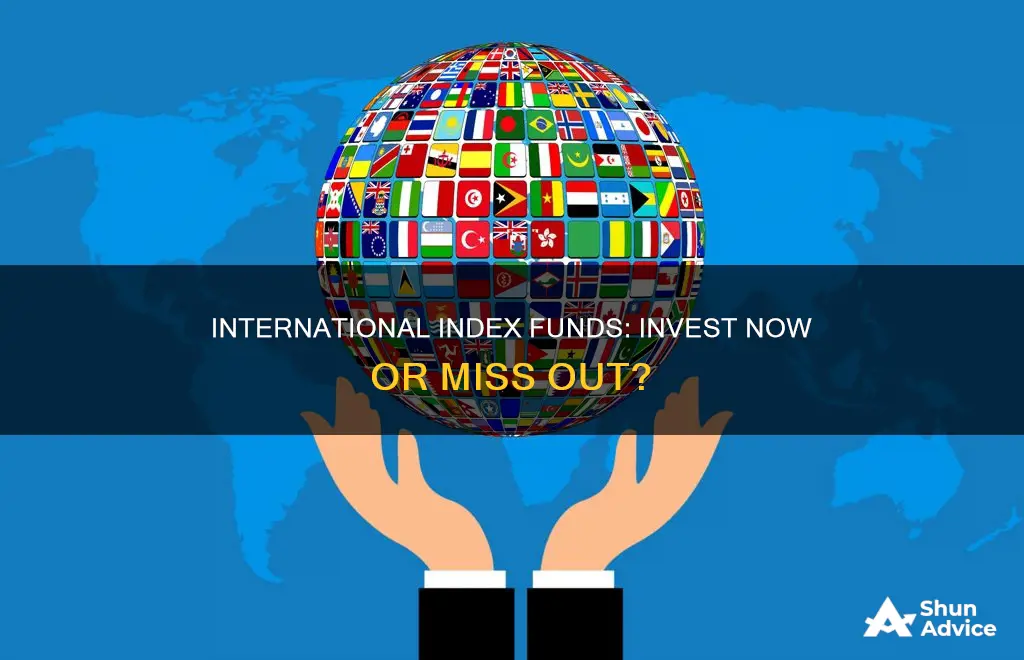
Index funds are a type of investment fund that tracks the performance of a market index, such as the S&P 500 or Nasdaq Composite. They are a passive investment strategy, meaning the fund manager aims to replicate the performance of the index without actively selecting stocks. This makes them a low-cost option for investors. While index funds are typically associated with domestic markets, international index funds are also available and can provide investors with exposure to foreign securities and markets. In this article, we explore the question of whether investors should consider adding international index funds to their portfolios. We will discuss the potential benefits and risks of investing in international index funds and provide an overview of some of the best international index funds currently on the market.
| Characteristics | Values |
|---|---|
| Purpose | Diversification, exposure to global growth and industry representation |
| Risk | Currency fluctuations, political issues, liquidity concerns |
| Investment Options | International funds, global funds, regional funds, developed markets funds, emerging markets funds |
| Recommended Allocation | Vanguard recommends at least 20% of the overall portfolio should be invested in international stocks and bonds |
| Advantages | Reduced reliance on domestic markets, enhanced returns, exposure to global economic growth, mitigation of geopolitical risks, access to underrepresented industries |
| Disadvantages | Volatility, currency risk, due diligence problems |
What You'll Learn

The benefits of international diversification
International diversification is a valuable strategy for investors seeking to reduce risk and enhance returns. Here are some key advantages:
- Reduced risk and enhanced returns: By investing in international markets, individuals can lower their dependence on domestic markets. This diversification can smooth out returns and provide a buffer during periods of domestic market underperformance.
- Exposure to global growth: Non-US stocks offer investors access to the growth of foreign economies, particularly those that are expanding faster than the US economy.
- Geopolitical risk mitigation: Investing in multiple countries helps to spread out geopolitical risks. For instance, an investor might balance their portfolio by including stocks from both emerging markets and more stable, industrialized nations.
- Currency diversification: Investing in international stocks and bonds provides exposure to different currencies. This can help neutralize currency fluctuations and protect against losses stemming from a decline in the US dollar.
- Access to diverse industries: International diversification allows investors to access industries that may be underrepresented in their domestic market. For example, US investors who only hold US multinational companies may be heavily invested in technology and healthcare but lack exposure to basic materials.
- Market cycle advantages: International diversification enables investors to take advantage of market cycles in different nations. For instance, an investor might seek opportunities in developing regions that are experiencing an influx of capital and increased demand for commodities.
- Improved portfolio performance: Research suggests that more diversified portfolios not only reduce potential losses but also tend to recover more quickly than less diversified portfolios.
- Lower transaction costs: While investing in international stocks often entails higher transaction costs, these can be mitigated by investing in international portfolios through exchange-traded funds (ETFs) or mutual funds.
- Long-term benefits: While the US stock market has outperformed non-US markets since the 2008 Global Financial Crisis, this trend may not persist indefinitely. Over the very long term (since 1970), the inclusion of international equities has generally improved the overall risk-adjusted returns of portfolios.
Closed-End Investment Funds: Where and How to Trade
You may want to see also

The risks of international diversification
International diversification can be a great way to reduce risk and enhance returns. However, there are several risks associated with investing in international markets that investors should be aware of.
Higher Transaction Costs
The biggest barrier to investing in international markets is the added transaction cost. Brokerage commissions in international markets are almost always higher than US rates. There can also be additional charges, such as stamp duties, levies, taxes, clearing fees, and exchange fees. These fees can add up quickly and eat into investment returns.
Currency Volatility
Currency volatility is another risk when investing in international markets. When investing in a foreign market, you must exchange your domestic currency for the foreign currency at the current exchange rate. If the foreign currency depreciates against your domestic currency, it will hurt your returns when you convert your money back. Currency volatility can be difficult to predict and can significantly impact investment returns.
Liquidity Risk
Liquidity risk is especially prominent in emerging markets. This is the risk of not being able to sell an investment quickly without incurring substantial losses due to a political or economic crisis. This risk is challenging to mitigate for the average investor and can result in unexpected losses.
Information Asymmetry
It can be difficult for investors to access reliable information about companies and markets outside their home country. This information asymmetry can lead to suboptimal investment decisions and increase investment risk.
Political and Economic Risk
Political, economic, and social events in foreign countries can be difficult to predict and understand, and they can have a significant impact on investment returns. For example, changes in government policies, economic crises, or social unrest can all affect the value of investments.
Legal Risk
It can be challenging to find legal remedies outside of an investor's home country. The laws and regulations governing investments can vary significantly between countries, and investors may not have the same protections as they do in their home country.
Endowment Funds: A Smart Investment for Your Future
You may want to see also

How to choose an international investment
International investments can be a great way to diversify your portfolio and reduce reliance on domestic markets. Here are some key considerations for choosing an international investment:
- Geographic location: Decide whether you want to invest in specific regions such as Asia-Pacific, Europe, or Latin America, or if you want a more global approach.
- Market type: You can choose between international funds that invest only in foreign markets, excluding the United States, or global/world funds that provide exposure to both foreign and U.S. markets.
- Market development: Developed markets are located in countries with established industries, widespread infrastructure, secure economies, and a high standard of living, such as the United Kingdom, Japan, and France. On the other hand, emerging markets are in countries with developing economies and less stable capital markets but often experience rapid growth, such as India, China, and Brazil.
- Risk and volatility: International markets are subject to additional sources of volatility, such as currency fluctuations. Developed markets tend to have similar volatility levels as the United States, while emerging markets are more volatile and have a wider range of potential outcomes.
- Diversification: International funds can provide access to hundreds or even thousands of foreign securities, reducing your reliance on the performance of any single market.
- Investment vehicle: You can invest in international markets through mutual funds or exchange-traded funds (ETFs). Mutual funds are typically more diversified and low-cost, while ETFs can be traded throughout the day and often have lower expense ratios.
- Performance and growth: Research the performance of international markets and individual securities to assess their growth potential. Keep in mind that international stocks can offer exposure to global economic growth and industries that may not be heavily represented in your domestic market.
- Costs and fees: International investing can be more expensive than investing in U.S. companies due to broker commissions and currency exchange rates. Compare the expense ratios of different funds and be mindful of any additional costs associated with trading on international exchanges.
- Information access: Many companies outside the U.S. do not provide the same type of information as U.S. public companies, and the information may not be available in English. This can make it challenging to conduct thorough research and due diligence.
- Legal and regulatory considerations: Understand the legal remedies available to you as a U.S. investor in international markets. Work with brokers or investment advisers who are registered with the SEC to ensure you have adequate protections.
Co-Investing: Why Funds Collaborate for Mutual Success
You may want to see also

The pros and cons of investing in index funds
Index funds are a popular investment choice as they offer the potential for more stable returns over time, a diversified portfolio of holdings, and low fees. However, it's important to be aware of their potential downsides. Here is a list of pros and cons to consider:
Pros:
- Passively managed: Index funds are passively managed, meaning fund managers take a hands-off approach and invest passively in companies in the market index it follows. This passive management style results in lower management fees than actively managed funds.
- Diversification: Index funds invest in numerous stocks, bonds, or other securities, reducing the risk of your portfolio being significantly harmed by the poor performance of a single stock.
- Long-term performance: Index funds tend to provide more stable and predictable returns over the long term. As such, they are often considered an excellent core asset for retirement accounts.
- Low fees: The fees on index funds are generally low because there is no active management.
- Better returns: Academic studies have shown that index funds tend to outperform actively managed funds over time.
- Consistency in achieving goals: Index funds allow investors to achieve their financial goals relative to benchmarks more consistently.
Cons:
- Lack of downside protection: Index funds leave investors vulnerable to market downturns.
- Lack of reactive ability: Index funds do not allow investors to take advantage of advantageous behaviours, such as reducing exposure to an overvalued stock.
- No control over holdings: Investors who buy into an index fund have no control over the individual holdings in the portfolio.
- Limited exposure to different strategies: Index funds are limited to well-established investment styles and sectors, and investors may miss out on successful strategies employed by active fund managers.
- Dampened personal satisfaction: Some investors may find index investing less satisfying than actively picking stocks, as it removes the excitement of making good investments and being successful with their money.
- Volatility: Stock indexes and the index funds that track them can be highly volatile, as seen in 2020.
- Lack of flexibility: Index funds lack the flexibility to respond quickly when the prices of the assets they hold fall.
- Moderate annual returns: A single index fund can hold a large number of assets, diluting the possibility of achieving significant annual returns.
- Fewer opportunities for short-term growth: Index funds are widely regarded as long-term investments with slower gains compared to individual stocks, options, crypto, or other higher-risk investments.
Ultimately, deciding whether to invest in index funds depends on your financial goals, risk tolerance level, and how well a fund fits within your overall financial plan.
Tax Managed Mutual Funds: Smart Investment or Not?
You may want to see also

How to invest in an index fund
Investing in an index fund is a great way to build wealth over time, and it's also a popular choice for retirement investors. Here's a step-by-step guide on how to invest in an index fund:
- Understand your investment goals: Before investing in an index fund, it's important to know what you want to achieve. Index funds are typically suitable for long-term investment goals, such as retirement planning.
- Research and choose the right index fund: There are different types of index funds available, such as broad market funds, sector funds, domestic funds, international funds, and bond funds. Consider your investment objectives and risk tolerance when selecting an index fund. Compare the fees and performance of different index funds to make an informed decision.
- Decide where to buy the index fund: You can purchase an index fund directly from a mutual fund company or a brokerage firm. If you already have a brokerage account, you can buy the index fund through your broker. Otherwise, you may need to open a new brokerage account.
- Determine your investment amount: Consider how much you can comfortably invest in the index fund. Some funds have minimum investment requirements, while others allow for fractional share purchases.
- Purchase the index fund: Once you have selected the index fund and determined your investment amount, you can proceed to buy the fund through your chosen platform. You may need to provide personal and financial information to complete the transaction.
- Monitor your investment: It's important to periodically review the performance of your index fund to ensure it aligns with your investment goals. Index funds are passive investments, but it's still essential to check their performance and make adjustments if necessary.
Monthly Investment Fund Setup: A Step-by-Step Guide
You may want to see also
Frequently asked questions
International index funds offer diversification, reducing reliance on domestic markets and potentially enhancing returns. They can also provide exposure to global economic growth, mitigate geopolitical risks, and tap into industries not heavily represented domestically.
International index funds carry their own special risks, such as currency fluctuations, political issues, and liquidity concerns. They can also be more volatile than domestic funds.
When choosing an international index fund, it's important to consider the fund's performance, expense ratio, and turnover ratio. You should also ensure that the fund matches your investment profile and conduct thorough due diligence.
The allocation to international stocks and bonds depends on your investment goals, risk tolerance, and overall portfolio composition. Vanguard recommends that at least 20% of your portfolio should be invested in international stocks and bonds, while financial planners typically suggest allocating 20% of your assets to non-U.S. stocks and bonds.







